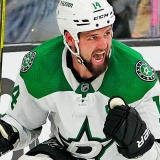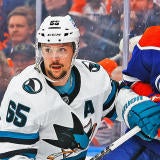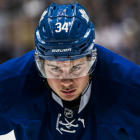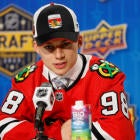
Even though a power play doesn't last long, it serves as an important component of every team's offense. In fact, approximately 21 percent of NHL goals in the 2016-17 season were scored when teams were operating with the man advantage. And in terms of fantasy, that figure can't be ignored.
The standard power-play unit may be comprised of five individuals, but they have to work together to improve their chances of succeeding. While familiarity and comfort rank among the top attributes to improve efficiency, one can't discount the importance of skill level and compatibility in the equation. If one of the components is not reliable in terms of stick work, skating or awareness, or if a club lacks sufficient right- or left-handed shooters, problems may arise.
A couple frontrunners surprisingly stuttered last year but are keen to reclaim past glory. Some sides lost key contributors over the break, while others have picked up essential upgrades. Based on projected lineups, here are the top 10 power-play squads heading into the season:
If there's one problem in Toronto, which featured the second-ranked power play last year, it's too many forward options – and that's a good problem to have. Auston Matthews increased his role throughout his rookie campaign, netting 21 points, and he's only going to improve. Mitch Marner and William Nylander, who combined for 47 man-advantage points, are bound to progress in similar fashion, although it's hard to perform much better than they already have. James van Riemsdyk's combination of size and soft hands plays well on the man advantage, where he's a year-in, year-out performer. Tyler Bozak and Nazem Kadri offer solid work dwon the middle, with the former serving as a key faceoff man and the latter adept at finding open space. The introduction of Patrick Marleau may add further selection headaches, but his 19-year resume – including 393 regular-season power-play points – will only enhance the Leafs' attack. Jake Gardiner and Morgan Rielly may be the featured defenders, but the efforts of Nikita Zaitsev cannot be overlooked.
With studs like Sidney Crosby and Evgeni Malkin in the fold, it may come as a surprise that Phil Kessel led all Penguins last year with 30 power-play points. Patric Hornqvist, Conor Sheary and Jake Guentzel comprise a fairly strong second tier. That said, while the awesome arsenal up front is impressive, Pittsburgh has questionable firepower at the point. Sure, Justin Schultz settled into his new home with a massive breakout in 2016-17 that included 20 points with the extra man, but it's highly questionable whether the oft-injured Kris Letang (neck) will be able to stay healthy and/or recover his old form. With Trevor Daley gone, maybe Olli Maatta earns an opportunity to renew the quarterbacking skills he once displayed in juniors. There's not a lot of offensive appeal on this blue line otherwise.
Last year's top power play will be in tough to repeat, but the Sabres rightly hold high hopes for the future. Jack Eichel and Ryan O'Reilly supply the talent down the middle – both tallied 24 power-play points last year. A late-season health scare may have temporarily taken out Kyle Okposo, but he's ready to resume his dominance around the net. Sam Reinhart, too, is aiming to keep the power-play points flowing after collecting 17 last year. While Evander Kane may be a perpetual enigma, he also possesses too much talent to ignore. Jason Pominville's return may see him reclaim a spot on special teams, but it's hard to expect much; meanwhile, fellow veteran Matt Moulson does almost all his work on the power play, where he collected 18 of his 32 points last year, including 11 goals. Unfortunately, the blue line isn't so pretty – Rasmus Ristolainen was its lone ray of light in 2016-17. As Jake McCabe and Zach Bogosian have proven underwhelming, the arrival of Nathan Beaulieu and Marco Scandella could supplement the output.
Nikita Kucherov has developed into a top scoring machine, as he tied for the league lead with 17 power-play goals among his 32 total points in man-advantage situations last season; fellow Triplets Line members Tyler Johnson and Ondrej Palat should provide plenty of help, too. If they have the benefit of a healthy Steven Stamkos, the Bolts could well move to the head of the class. Even though they're young, both Brayden Point and Vladislav Namestnikov know the ropes, giving the Bolts valuable depth. Alex Killorn isn't flashy, but he cracked double-digit power-play points for the first time last year, while newcomer Chris Kunitz adds a wealth of winning experience, though he's in the twilight of his career. Know who led all players in power-play assists last season? If you said Victor Hedman with 29, then either you've done your research or you're good at guessing. The rest of the rearguard contingent appears thin, though, with Anton Stralman having taken a step back (from 14 and 12 points the previous two seasons to seven last year), while Jake Dotchin has yet to show much at the NHL level.
The main story in Alberta's capital revolves around Connor McDavid and the 27 power-play points he included among last year's 100 total, but there's enough in reserve to make the Oilers a formidable force. Leon Draisaitl is coming off a dramatic improvement from nine points in 2015-16 to matching McDavid's total last year. If Milan Lucic – who exploded for 12 goals and 13 assists on the power play, both career highs, while mostly looking lost and slow at even strength – falters as the net-front presence, Patrick Maroon will gladly step in and join McDavid on the top unit. While Mark Letestu may not be much of a contributor overall, he made his mark in special-teams duty with 14 points last year. Being the third center may not have been what Ryan Nugent-Hopkins had in mind as the 2011 draft's No. 1 overall pick, but at least he still holds a power-play role, which resulted in 11 extra-man points last year. Ryan Strome, brought in from the Islanders, will try to fill the void left behind by the guy he was traded for, Jordan Eberle; Anton Slepyshev and Jesse Puljujarvi are options on the right wing too. Edmonton is another club suffering from a dearth on D, with Oscar Klefbom the only decent healthy option. With Andrej Sekera sidelined until at least November (and perhaps much longer), veteran Kris Russell should get a shot at a prominent power-play position.
The Caps would seem to be shoo-ins for a higher spot on this list, considering Alex Ovechkin's lethal shot (he managed 17 power-play goals even in a down season last year) and Nicklas Backstrom's uncanny vision, but roster uncertainty knocks them down the charts. While no complaints can be issued regarding Evgeny Kuznetsov and T.J. Oshie, the defections of Marcus Johansson and Justin Williams have removed a sizable chunk of man-advantage output (they combined for 29 power-play points last year), so one or more of Andre Burakovsky, Jakub Vrana and Brett Connolly will need to pick up the slack – there's plenty of talent there, though, so that's not an unreasonable ask. Late-season rental Kevin Shattenkirk left for Broadway and John Carlson suffered through a few slumps (although his 16 extra-man points still play), but Matt Niskanen remains an able performer and Dmitry Orlov has grown into a larger offensive role.
Even though the Jets didn't impress in this category last year, they boast plenty of dangerous weapons who could help them improve in 2017-18. Let the record show that seven Winnipeg skaters notched at least 12 man-advantage points last season. Blake Wheeler's 21 led the way, and veterans Mathieu Perreault and Bryan Little provide competent secondary productivity, but the key to Winnipeg's success can be found in its youth movement. Mark Schiefele is already a stud, and he's established a positive rapport with rising star Patrik Laine and electric winger Nikolaj Ehlers – that's a highly dangerous trio. And don't forget about 20-year old Kyle Connor (45 points in 51 AHL games), who's primed to break out at the top level. Dustin Byfuglien may be the club's No. 1 blueliner, but he'll have to fight off young upstart Jacob Trouba; the competition may be good for both of them. Well past his prime years, Tobias Enstrom is no longer a threat, while Tyler Myers will have to overcome a horrific injury resume if he ever wants to regain fantasy relevance.
The Blueshirts lost a leader and one of their top scorers in Derek Stepan when they dealt him to Arizona this offseason, but they also added a world-class power-play quarterback in Kevin Shattenkirk, who's averaged 26 power-play points over the last four years. The primary responsibilities now fall on Mats Zuccarello (14) and Chris Kreider (13) as well as newly promoted No. 1 center Mika Zibanejad, who'll be looking for a big year after his NYC debut got cut short by injury. Although his offensive skills are in deep decline, Rick Nash can still use his large frame to his advantage. Same goes for Kevin Hayes, who stands to benefit from extra playing time following Stepan's departure, while J.T. Miller should earn more special-teams minutes thanks to his hard work. If Jimmy Vesey can't consistently find the scoresheet again after disappointing as a rookie, Pavel Buchnevich could easily surpass the former Hobey Baker winner. With Shattenkirk as well as the young and talented Anthony DeAngelo in the fold, there should be less pressure on Ryan McDonagh to produce on the man advantage this year, which is a good thing. Brady Skjei turned out to be a pleasant surprise as a rookie, but it's questionable how much power-play time will be available for him this year thanks to the new additions.
Patrick Kane acts as the superhero here, having netted 23 points with the extra man last year, while Jonathan Toews serves as a trusty sidekick despite his relatively unspectacular overall production. The impact of Brandon Saad's return to Chicago cannot be underestimated, although the loss of Artemi Panarin's dynamic playmaking could end up hurting Russian compatriot Artem Anisimov. Marian Hossa's sabbatical will provides Richard Panik with more opportunities after last year's surprising offensive uptick. Once upon a time, Patrick Sharp was a key power-play contributor for this club, but it's doubtful that he'll be able to return to his glory days. Among the Hawks' youth, Nick Schmaltz holds the most potential to increase his special-teams duty. On the blue line, both Duncan Keith and Brent Seabrook are still capable hands, but it's unclear to whom the Blackhawks might turn if either of their two big guys goes down. Michal Kempny, Jan Rutta and Connor Murphy are all candidates, but not exciting ones.
10. Dallas Stars
Considering that perennial producers Tyler Seguin and Jamie Benn combined for 55 power-play points, it's shocking that the Stars ranked 20th on the man advantage last season, but no other forward besides Jason Spezza and the departed Patrick Eaves performed at a decent rate. That's why management brought on Alexander Radulov after he notched 16 points for a weak Montreal attack, but he'll probably play on the top unit with Benn and Seguin, perhaps making them even more explosive. What the Stars really need is some scoring depth from their under-25 crowd up front – chiefly, Devin Shore, Radek Faksa, Brett Ritchie and Mattias Janmark. Although top blueliner John Klingberg needs to be more consistent to be considered an elite scorer, we're still talking about a guy who's already accumulated 51 power-play points over three seasons. The door is open for major contributions from talented prospect Julius Honka – he may not steal Klingberg's coveted place on the top unit, but he could be key to improving the second unit's play. Similarly, fellow Finn Esa Lindell could also break through after a promising rookie year.





















